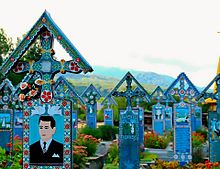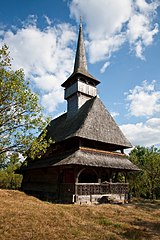
The regions Sathmar and Maramureș (also called Maramuresch or Marmarosch; Romanian Sătmar și Maramureș) are in the north Romania, on the border with Ukraine and Hungary.

places

- 2 Sighetu Marmației
 (Marmaroschsiget). the center of the "real" Maramures on the border with Ukraine.
(Marmaroschsiget). the center of the "real" Maramures on the border with Ukraine. - 4 Borșa
 (Borscha)
(Borscha) - 5 Breb. A village that is a great example of true Maramures culture. The only village with cheap travel infrastructure.
Other goals


- Wooden churches in the Maramureș (Biserici de lemn din Maramureș). The wooden churches in Maramureș are around 60 churches, 45 of them in Romania and 15 in the neighboring area of Ukraine. Eight of them have been protected as UNESCO cultural heritage since 1999.

- 1 Rodna Mountains National Park (Parcul Național Munții Rodnei). With 28 glacial lakes (including Lake Știolu), various karst features such as karst glaciers, numerous limestone caves and waterfalls (e.g. Cascada Cailor) and Mount Pietros (2303 m), the highest point in the Eastern Carpathians. In the east of the district, on the DN 18 between Borșa and Iacobeni.
- 2 Maramureş Mountains Natural Park (Parcul Natural Munții Maramureșului). In the northeast of the district on the border with Ukraine, with spectacular mountain scenery, protected flora and fauna, accessible via Vişeu de Sus.

- 1 Cimitirul Vesel (Lângă biserica ortodoxă și cimitirul vechi). At the Merry Cemetery in Săpânţa, a local artist designed all the tombs with naive paintings that characterize the deceased.
- 1 Wassertalbahn (CFF Vișeu, Vaser Valley Forestry Railway). The Viseu de Sus forest railway is a unique example of technical heritage. Wood steam locomotives are still running on a network of around 60 kilometers of narrow-gauge railway, along with several diesels and railcars. The CFF Viseu de Sus ("CFF" stands for "Caile Ferate Forestiere" - forest railway in Romanian) is probably the last real forest railway that still runs with steam locomotives in Europe.
background
The historical regions of Sathmar and Maramureș go to two counties (Hungarian Szatmár and Maramaros) back in the former Kingdom of Hungary, to which both belonged until the end of the First World War. The former continues in the northeast of what is now Hungary, the latter in the southwest of Ukraine. The Romanian parts coincide roughly with today's administrative districts (Județe) Satu Mare and Maramureș (capital Baia Mare). For reasons of practicality, they are often grouped together, for example in the Romanian Orthodox diocese of Maramureș and Sathmar. In terms of landscape, however, they are very different: while the Sathmar area is largely flat or slightly hilly and only rises in the easternmost part, the Maramureș is characterized by the densely forested high mountains of the Eastern Carpathians, which reach 2303 meters with the highest mountain Pietros.
language
First and foremost, Romanian is spoken. In the Sathmar region there is also a strong Hungarian minority (35%); There are notable Hungarian (9%) and Ukrainian (7%) minorities in the Maramureș region. The traditional German minority of the Sathmar Swabians is hardly represented today (less than 2%). Since the German school in Satu Mare is also very popular among Romanians and German is also taught as a foreign language at some Romanian schools, with a little luck you will meet one or the other German speaker.
getting there
Baia Mare and Satu Mare each have a small regional airport. The closest international airports are in Cluj-Napoca (140 km from Baia Mare) and Debrecen (Hungary; 110 km from Satu Mare).
The best way to travel from German-speaking countries by train is via Debrecen. From there a regional train goes to Satu Mare, Baia Mare and many other train stations in the region. The fastest connections from Vienna take around 9 hours.
On the Hungarian side, a motorway leads close to the border. From Vienna you need 5½ to 6 hours for the 600 kilometers to Satu Mare, and a good 6½ hours for the 650 kilometers to Baia Mare.
mobility
activities
- Fixed and regular events
- Winter traditional festival in Negreşti-Oaş with a Colindă parade (Colindă are traditional Romanian Christmas carols), with the singers appearing in the costumes of their place of origin
- National "Sâmbra oilor" festival in Țara Oașului - traditional festival with dance and costumes on the occasion of the sheep being raised to the pastures
- International multicultural theater festival Fără Bariere / Sorompók Nélkül (“Without borders”), takes place in and around the end of May every year Satu Mare instead of.





.JPG/350px-BrebMM_(88).JPG)
.JPG/320px-Biserica_Sfanta_Varvara_din_CavnicMM_(11).JPG)




.JPG/159px-IeudBisDinDeal_(73).JPG)
.JPG/350px-PlopisMM_(153).JPG)






